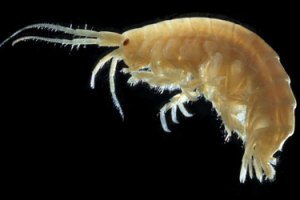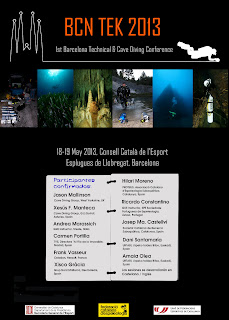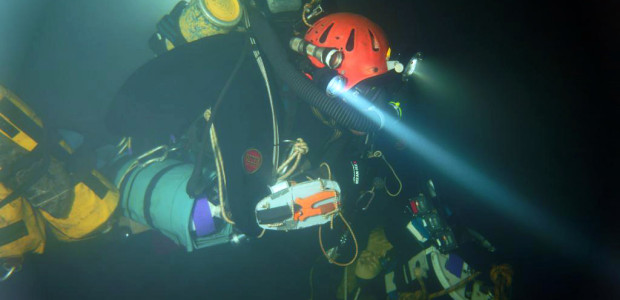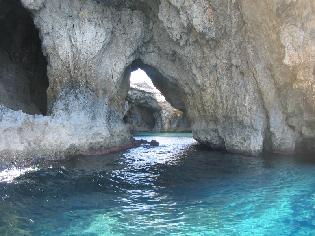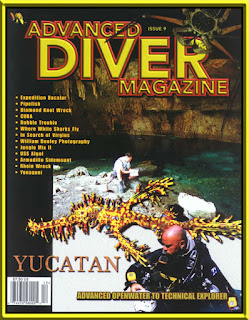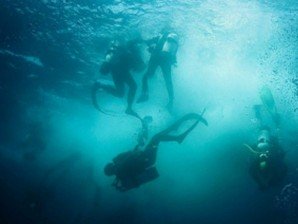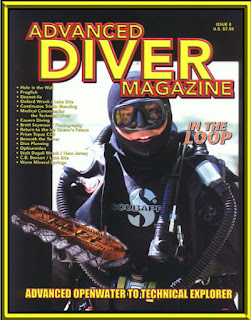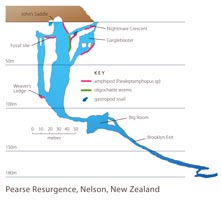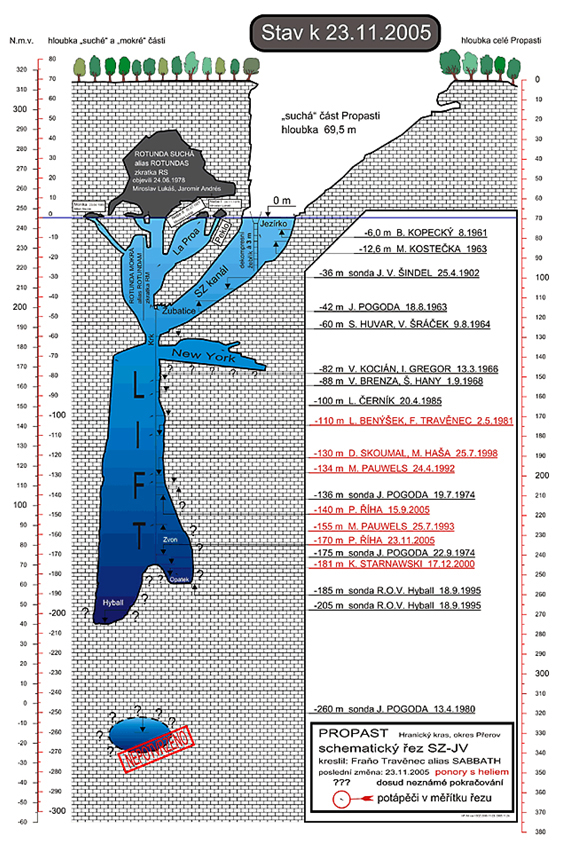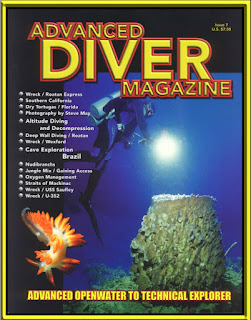A new species of amphipod, unknown until today to scientists, has been found in the cave Melissotripa Elassonas in Larissa, in the region of Thessaly, after research that lasted two years.
The new organism was discovered by German and Romanian speleologists, led by the cavediver Markos Vaxenopoulos, a scientific associate of the Natural History Museum of Volos.
The new species belongs to the genus Nighargus and lives exclusively in a small lake in the cave of Melissotripa. It plays a important role in speleogenesis and its identification was carried out on the basis of its morphological features and the DNA analysis.
According to ethnis.gr, except from this tiny species of amphipod, the researchers also observed in the cave Melissotripa that was first explored in 2007, an array of impressive stalactites and stalagmites, as well as bats.
The cave is easily accessible in its biggest part. However, there are bottlenecks and difficult passages. The temperature in the entrance of the cave reach about 55 degrees Fahrenheit, and about 62 in the interior, where the humidity is 100 percent. There were three lakes in the cave, but now only one of them is left.
Showing posts with label cave diving. Show all posts
Showing posts with label cave diving. Show all posts
Saturday, June 1, 2013
Amphipod Species Found In Larissa Cave
Email ThisBlogThis!Share to TwitterShare to FacebookShare to Pinterest
Sunday, April 21, 2013
First Barcelona Technical & Cave Diving Conference: BCN TEK 2013
On 18th & 19th May, the First Barcelona Technical & Cave Diving Conference will take place focusing on cave diving explorations.
Topics presented include :
- recent explorations at the terminal sumps of Sistema Huautla -1545m (Mexico)
- Pozo Azul (over 9km diving distance)
- Lamina'ko Ziloa (Saint Georges system resurgence in the Pyrenees)
- Fuentona de Muriel, Escuain, Cotiella, also explorations in Portugal and Bosnia, ...
Click on the image on the left for the full details about the talks.
More information can be found on the BCN TEK 2013 facebook group, subscription form can be downloaded here.
Email ThisBlogThis!Share to TwitterShare to FacebookShare to Pinterest
Tuesday, April 16, 2013
Cave Depth Record Achieved Using KISS Rebreather
Mexico’s Sistema Huautla is perhaps one of the most complex of the world’s deep caves. With 17 entrances and numerous independent and physically demanding deep routes, dropping nearly a mile into the earth, this dark labyrinth requires extensive rope work and multiple days of effort to reach the lower depths of the system. The last extension to the cave took place in 1994, when Dr William Stone used his self-designed CIS Lunar rebreather to pass what was then considered the terminal sump. Staging their dive from a portable platform suspended over a pool of water, the transiting a flooded tunnel and went on to discovered some 3.3km (2 miles) of new passage, but were ultimately stopped by Sump 9.(...)
Read more: UnderWaterJournal.com
Email ThisBlogThis!Share to TwitterShare to FacebookShare to Pinterest
Monday, December 24, 2012
Video: Cave diving in Roubidoux Spring
Probably the most popular cave dive is in Roubidoux Spring, Waynesville (Mo).
Roubidoux Spring is open to certified cavern/cave divers who must check in and present their cave/cavern certification card to the officials in the 911 Emergency Center prior to diving. The center is located adjacent to the Fire Station on top of the hill off Highway 66 just east of downtown. There is no diving fee or permit required. Be sure to sign out after diving!
More information on the exploration of this cave can be found here.
Roubidoux Spring is open to certified cavern/cave divers who must check in and present their cave/cavern certification card to the officials in the 911 Emergency Center prior to diving. The center is located adjacent to the Fire Station on top of the hill off Highway 66 just east of downtown. There is no diving fee or permit required. Be sure to sign out after diving!
More information on the exploration of this cave can be found here.
Email ThisBlogThis!Share to TwitterShare to FacebookShare to Pinterest
Friday, December 7, 2012
San Actun and dos Ojos cave System - World's 2nd longest cave
The following team helped surveying the new connection: Don Arburn, Gill Ediger, Aida Ferreira, Devra Heyer, Carrie Hutchins, Pat Kambesis, Chris Lloyd, Rene Rogers Ohms, Bev Shade, Peter Sprouse (the cartographer), Terri Sprouse, German Yanez, and Jacinto Vela.
The cave system is now the longest underwater cave system known to man, with a total surveyed length of 308,407 m (=308 km) and a depth of 127.6 m, making it at the same time the second longest cave in the world (See Bob Gulden's list of longest caves in the world).
A complete report can be found in the December 2012 edition of the NSS news.
We are also pleased to report a recent underwater connection between Sistema del Mundo Escondido and Sistema Sac Actun by Alex Reato.
Future information on the exploration can be found on the website from the Quintana Roo Speleological Survey.
Email ThisBlogThis!Share to TwitterShare to FacebookShare to Pinterest
Sunday, September 9, 2012
Cave divers discover massive grotto hidden in the depths of Cheddar Gorge
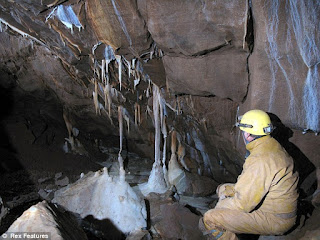 |
| New discovery: The giant underground chamber, named The Frozen Deep, that has recently been found inside Cheddar Gorge in Somerset. |
The huge space, which had been named 'The Frozen Deep' by the team, is a staggering 60 metres in diameter and reaches up to 30 metres high.
It contains stunning calcite formations - including two pure white columns each standing at five-metres tall - surrounded by white flowstone on the walls and floor.
'Tuesday Diggers', a group of local cave divers, discovered the chamber after spending four hours a week for four years digging, breaking rocks and opening 50cm passages.
Hugh Cornwell, director of Cheddar Gorge and Caves, in Somerset, said: 'This is a truly significant discovery by the 'Diggers' which opens up a fascinating new chapter in the history of Mendip cave exploration.
'The question already emerging is whether they can now find a connection from The Frozen Deep to the River Cave.
Email ThisBlogThis!Share to TwitterShare to FacebookShare to Pinterest
Sunday, September 2, 2012
Four Hebrew U. researchers reach new lows in Abkhazia, and find new species of transparent fish
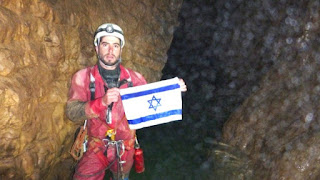 |
| Boaz Langford of the Israeli cave exploration delegation at a depth of 2,080 meters in the Krubera-Voronya cave in Abkhazia |
The four explorers — Boaz Langford, Leonid Fagin, Vladimir Buslov and Yuval Elmaliach — joined the Ukrainian Speleological Association as part of an international delegation that aimed to break the world record for deepest place reached by spelunkers. On the team, which just returned from the trip, were members from nine countries, including Israel and Lebanon.
“The purpose of the venture was to break the world’s record for cave exploration — an achievement reached when a Ukrainian researcher reached a depth of 2,196 meters beneath the earth’s surface, five meters deeper than the previous record,” Professor Amos Frumkin of the Department of Geography at the Hebrew University, who heads the university’s cave research unit, said in a press statement on Sunday.
Email ThisBlogThis!Share to TwitterShare to FacebookShare to Pinterest
Friday, August 24, 2012
Young British snorkeller drowns in Comino caves
A 20-year-old Briton drowned while snorkelling in underwater caves around Santa Marija Bay in Comino yesterday afternoon.
Marcus Hughes-Hallet was on holiday with his parents and was diving from one cave to the other when he “got stuck in the rocks beneath the caves,” the Armed Forces of Malta said.
His father called for help and a number of people dived down to look for him. After several attempts they managed to bring him to the surface but Mr Hughes-Hallet was not breathing, the AFM said.
Marcus Hughes-Hallet was on holiday with his parents and was diving from one cave to the other when he “got stuck in the rocks beneath the caves,” the Armed Forces of Malta said.
His father called for help and a number of people dived down to look for him. After several attempts they managed to bring him to the surface but Mr Hughes-Hallet was not breathing, the AFM said.
Email ThisBlogThis!Share to TwitterShare to FacebookShare to Pinterest
Tuesday, August 21, 2012
Lethal cave diving accident in Ilyuhinskaya
On August 20th cave diver Alexei Savelyev passed away after an accident in the second siphon of the Ilyuhinskaya cave at a depth of around 1000 m.
He was a member of the Sokolniki club, who were exploring the cave. Together with his diver partner Aleksey Aksenov he was on his way back from explorations beyond the 4th siphon.
Source: Cavers Mailing List & Sokolniki RUDN
His dive partner tried to resuscitate him but he was unsuccesful.
Currently, participants of nearby expeditions (Kuybishevskaya, Voronya) are working together with the expedition team to extract the body from the cave.
Currently, participants of nearby expeditions (Kuybishevskaya, Voronya) are working together with the expedition team to extract the body from the cave.
Given the depth and many obstacles along the way (including a siphon), the rescue action is going to be long and difficult.
Our thoughs go out to all family, friends and fellow cave divers.
Our thoughs go out to all family, friends and fellow cave divers.
Source: Cavers Mailing List & Sokolniki RUDN
Email ThisBlogThis!Share to TwitterShare to FacebookShare to Pinterest
Thursday, August 16, 2012
Cave diver picks up award after brave rescue bid
 |
| Richard Stanton |
Richard Stanton, of Allesley Old Road, reached spectacular depths in a courageous effort to find a French diver back in 2010.
He was given special leave from his job as a city firefighter to join a team at the Ardeche Gorge, near Marseille, for the mission to rescue Eric Establie, who had been attempting to explore a deep and dangerous cave.
More than a week after he had gone missing - and after days of repeated and unsuccessful dives in horrendous conditions - Mr Stanton found the Frenchman's body. He had died after getting trapped following an underwater avalanche.
Email ThisBlogThis!Share to TwitterShare to FacebookShare to Pinterest
Thursday, August 9, 2012
Video: Pearse Resurgence expedition in New Zealand
A few highlights of this year's Pearse Resurgence expedition in New Zealand, where divers pushed the cave to a new depth of 221m and discovered another 100m of passage.
--
--
--
--
--
--
--
--
--
--
--
--
--
--
--
--
--
--
--
--
--
The Wet Mules have just completed the 2012 expedition to the Pearse River Resurgence near Mt Arthur in the South Island of New Zealand. The six Mules (David Bardi, Craig Challen, John Dalla-Zuanna, Richard “Harry” Harris, Ken Smith and Sandy Varin), were accompanied by diving physician and support Dr Karen Richardson for the 17 day trip.
Both primary objectives of the trip were accomplished. With the assistance of Nelson Speleological Group’s Andrew Smith and Dawn Wood, dye tracing from the Spillway in Nettlebed Cave again confirmed the connection between the two sites. Unfortunately, the dye appeared to be coming from the main passage deeper than 120m, so any hopes of making a shallow connection were lost.
Hence attention shifted back to pushing the deep section of the cave, and once the four habitats were installed at 7, 16, 28 and 38m, and gas was staged in the cave, build-up dives commenced.
On Thursday 12th January Dave and Sandy dived to 180m and completed an extraordinary 7 hour all in-water decompression.
The following day Richard Harris pushed past the end of Craig’s 2011 line at 194m, and laid 70m of line in large passage to a maximum depth of 207m. A total run time of 10½ hours was spent in comfort thanks to the habitats and the surface supplied suit-heating systems.
After two days of rain the resurgence flooded, delaying diving for a day. The final push dive by Craig Challen began on Sunday 15th January as the water levels subsided. Tying off to the end of Harry’s line, he scootered on a short distance only to meet another steep descent. Craig made a final tie off at 221m and returned to the surface after a total dive time of 17 hours. The passage continues beyond, heading deeper.
Ken, JDZ and Craig made tape measure surveys of several areas including the Nightmare Crescent and Big Room area at 120m.
The Wet Mules have just completed the 2012 expedition to the Pearse River Resurgence near Mt Arthur in the South Island of New Zealand. The six Mules (David Bardi, Craig Challen, John Dalla-Zuanna, Richard “Harry” Harris, Ken Smith and Sandy Varin), were accompanied by diving physician and support Dr Karen Richardson for the 17 day trip.
Both primary objectives of the trip were accomplished. With the assistance of Nelson Speleological Group’s Andrew Smith and Dawn Wood, dye tracing from the Spillway in Nettlebed Cave again confirmed the connection between the two sites. Unfortunately, the dye appeared to be coming from the main passage deeper than 120m, so any hopes of making a shallow connection were lost.
Hence attention shifted back to pushing the deep section of the cave, and once the four habitats were installed at 7, 16, 28 and 38m, and gas was staged in the cave, build-up dives commenced.
On Thursday 12th January Dave and Sandy dived to 180m and completed an extraordinary 7 hour all in-water decompression.
The following day Richard Harris pushed past the end of Craig’s 2011 line at 194m, and laid 70m of line in large passage to a maximum depth of 207m. A total run time of 10½ hours was spent in comfort thanks to the habitats and the surface supplied suit-heating systems.
After two days of rain the resurgence flooded, delaying diving for a day. The final push dive by Craig Challen began on Sunday 15th January as the water levels subsided. Tying off to the end of Harry’s line, he scootered on a short distance only to meet another steep descent. Craig made a final tie off at 221m and returned to the surface after a total dive time of 17 hours. The passage continues beyond, heading deeper.
Ken, JDZ and Craig made tape measure surveys of several areas including the Nightmare Crescent and Big Room area at 120m.
Extra resources:
http://www.wetmules.com/home/mules-in-action/pearseexpedition2012news
http://www.stuff.co.nz/nelson-mail/news/6289155/Australian-divers-reach-record-depths-in-caves
http://www.advanceddivermagazine.com/articles/pearse/pearse.html
http://www.deepdiving.net/pearse/
Email ThisBlogThis!Share to TwitterShare to FacebookShare to Pinterest
Monday, July 16, 2012
Ebook: Spanish Cave Diving Manual
Click below for the Spanish Cave Diving Manual: "Fundamentos básicos del buceo en cuevas y grutas" by Andrès Ros, José L. Llamusi, Angel Ortego and Carmen Portilla.
Email ThisBlogThis!Share to TwitterShare to FacebookShare to Pinterest
Tuesday, July 10, 2012
Mystic Cave: Cave Diving Video
Email ThisBlogThis!Share to TwitterShare to FacebookShare to Pinterest
Thursday, July 5, 2012
Advanced Diver Magazine: Issue 9
|
| Content:
|
Email ThisBlogThis!Share to TwitterShare to FacebookShare to Pinterest
Monday, July 2, 2012
Pictures and updated map of Hranická Propast
.jpg) | A few days ago we already reported about this expedition. See this blog post for the video of the dive. Now Krzysztof Starnawski sent an update with a new map of the cave and some extra pictures and tells us firsthand how the expedition went: |
"We just concluded another two day exploration of Hranicka Propast cave. This time i laid guide line from 196 m. to 217 m., passing on 200 meters restriction discovered during our January 2012 expedition.
This restriction is created by fallen rocks and waterlogged tree trunks. Newly discovered passage is huge and has potential to reach 400 meters. Cave is situated in calcium sediment rock which is 600 meters thick, water is warm with heavy mineral content which tells us that is coming from below limestone.
Outcome of our last expedition with terrain geology knowledge allows us to hope that Hranicka Propast can become the deepest submerged cave in the world and her depth can be over 400 meters. Reach to this type of depth is just a question of time since passage is already mapped and guide line is secured.
Restriction discovered in January ended up being way easier than I expected, not that narrow and as I was hoping leads to deeper parts of the cave. Only problem is large amount of waterlogged tree trunks and huge boulders. Thankfully, diver using CCR is not generating large amounts of gas bubbles which could destabilize this tight spot.
Email ThisBlogThis!Share to TwitterShare to FacebookShare to Pinterest
Sunday, July 1, 2012
Divers drown in underwater cave in Italy
Four scuba divers drowned after becoming trapped in a cave on Italy’s southwest coast, authorities said on Saturday.
The three men and one woman were part of a larger group that had set off to explore Blood Cave, one of a series of underwater caves popular with amateur divers.
Several members of the group managed to get out of the cave in the Salerno Gulf near the small port of Palinuro, authorities said, but the four others - three Italians and one Greek - were left behind.
Police named the Italians as Andrea Pedroni and Douglas Rizzo, both 40 and from Rome, and 36-year-old Susy Covaccini from Salerno.
Rizzo, the group leader, was the father of a seven-month-old baby.
Panaghiotis Telios, a 23-year-old Greek man living in southern Calabria, also died.
No official explanation was given for the tragedy but rescuers and members of the group who escaped unhurt believed the divers could have caused large quantities of sand to shift as they swam through the cave’s many passages, which then blocked their visibility, causing them to lose their way.
The group’s diving instructor survived.
The string of 35 underwater caves include the Blood Cave - so-called for the red colouring of its walls caused by bacteria - and the Blue Cave, a favorite with scuba divers.
The three men and one woman were part of a larger group that had set off to explore Blood Cave, one of a series of underwater caves popular with amateur divers.
Several members of the group managed to get out of the cave in the Salerno Gulf near the small port of Palinuro, authorities said, but the four others - three Italians and one Greek - were left behind.
Police named the Italians as Andrea Pedroni and Douglas Rizzo, both 40 and from Rome, and 36-year-old Susy Covaccini from Salerno.
Rizzo, the group leader, was the father of a seven-month-old baby.
Panaghiotis Telios, a 23-year-old Greek man living in southern Calabria, also died.
No official explanation was given for the tragedy but rescuers and members of the group who escaped unhurt believed the divers could have caused large quantities of sand to shift as they swam through the cave’s many passages, which then blocked their visibility, causing them to lose their way.
The group’s diving instructor survived.
The string of 35 underwater caves include the Blood Cave - so-called for the red colouring of its walls caused by bacteria - and the Blue Cave, a favorite with scuba divers.
Source: Inquirer News
More info (Fr) on: Liberation
More info (Fr) on: Liberation
Email ThisBlogThis!Share to TwitterShare to FacebookShare to Pinterest
Friday, June 29, 2012
Advanced Diver Magazine: Issue 8
|
| Content:
|
Email ThisBlogThis!Share to TwitterShare to FacebookShare to Pinterest
Thursday, June 28, 2012
Pearse Resurgence: Cave divers discovered three new species
Cave divers discovered several new species - a transparent amphipod, a worm, and a small snail -in the Pearse Resurgence, a system in the remote Motueka Valley on the South island of New Zealand near Nelson. Pearse Resurgence is connected to the Nettlebed Cave, a deep, extensive cave system in the Mount Arthur Range. It was thought to be the deepest cave system in the southern hemisphere until divers pushed deeper in the nearby Ellis Basin cave system during an expedition in April 2010.
"It's not easy to get inside the caves, and we want to know about the very specific life in them," says Dr. Graham Fenwick, a scientist at New Zealand’s National Institute of Water and Atmospheric Research (NIWA). "It's important to do an inventory of life in New Zealand, and in this case, it's a pretty special type of environment, and we don't have many limestone karst systems that are readily explored."
Worldwide, these aquifer studies are yielding rich troves of biodiversity. The importance of the stygofauna is twofold - they contribute to the health of the aquifer by biofiltration and in turn they may represent an important marker of the health of the water.
"It's not easy to get inside the caves, and we want to know about the very specific life in them," says Dr. Graham Fenwick, a scientist at New Zealand’s National Institute of Water and Atmospheric Research (NIWA). "It's important to do an inventory of life in New Zealand, and in this case, it's a pretty special type of environment, and we don't have many limestone karst systems that are readily explored."
Worldwide, these aquifer studies are yielding rich troves of biodiversity. The importance of the stygofauna is twofold - they contribute to the health of the aquifer by biofiltration and in turn they may represent an important marker of the health of the water.
Email ThisBlogThis!Share to TwitterShare to FacebookShare to Pinterest
Czech Cave Diving Expedition into Hranická Propast reaches depth of 217 m
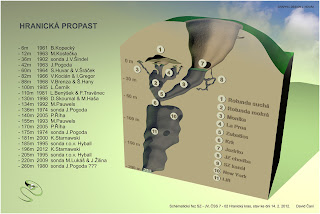 The Hranická Propast cave is located in the east of the Czech Republic, near the town of Moravě.
The Hranická Propast cave is located in the east of the Czech Republic, near the town of Moravě.To enter the cave you have to climb the 315 m high Hůrka hill. Previously divers have installed a cable guidance system to lower their gear easily.
Diving in the cave is pleasant as the water temperatue is about 15-16°C all year round.
The first dives in the cave were done in the sixties. As the system got deeper and deeper people started wondering how far it would go and send in remotely operated vehicles (ROV) in search for the bottom of the well.
Krzysztof Starnawski is now pushing the limits even further.
During a 7.5 h dive, he reached an incredible depth of 217 m. The previous record was -200 m which he accomplished earlier this year. See the bottom of this post for the previous video report.
Below you can see a video report of a the Czech Cave Diving Expedition in the Hranická Propast system, where diver Starnawski went to a depth of 217 m. The film was shot with a GoPro camera, and GRALmarine light.
More info on the cave can be found at his webpage http://www.dualrebreather.com or at http://www.hranickapropast.cz
Email ThisBlogThis!Share to TwitterShare to FacebookShare to Pinterest
Wednesday, June 27, 2012
Advanced Diver Magazine: Issue 7
|
| Content:
|
Email ThisBlogThis!Share to TwitterShare to FacebookShare to Pinterest
Subscribe to:
Posts (Atom)
Showing posts with label cave diving. Show all posts
Showing posts with label cave diving. Show all posts
Saturday, June 1, 2013
Amphipod Species Found In Larissa Cave
A new species of amphipod, unknown until today to scientists, has been found in the cave Melissotripa Elassonas in Larissa, in the region of Thessaly, after research that lasted two years.
The new organism was discovered by German and Romanian speleologists, led by the cavediver Markos Vaxenopoulos, a scientific associate of the Natural History Museum of Volos.
The new species belongs to the genus Nighargus and lives exclusively in a small lake in the cave of Melissotripa. It plays a important role in speleogenesis and its identification was carried out on the basis of its morphological features and the DNA analysis.
According to ethnis.gr, except from this tiny species of amphipod, the researchers also observed in the cave Melissotripa that was first explored in 2007, an array of impressive stalactites and stalagmites, as well as bats.
The cave is easily accessible in its biggest part. However, there are bottlenecks and difficult passages. The temperature in the entrance of the cave reach about 55 degrees Fahrenheit, and about 62 in the interior, where the humidity is 100 percent. There were three lakes in the cave, but now only one of them is left.
The new organism was discovered by German and Romanian speleologists, led by the cavediver Markos Vaxenopoulos, a scientific associate of the Natural History Museum of Volos.
The new species belongs to the genus Nighargus and lives exclusively in a small lake in the cave of Melissotripa. It plays a important role in speleogenesis and its identification was carried out on the basis of its morphological features and the DNA analysis.
According to ethnis.gr, except from this tiny species of amphipod, the researchers also observed in the cave Melissotripa that was first explored in 2007, an array of impressive stalactites and stalagmites, as well as bats.
The cave is easily accessible in its biggest part. However, there are bottlenecks and difficult passages. The temperature in the entrance of the cave reach about 55 degrees Fahrenheit, and about 62 in the interior, where the humidity is 100 percent. There were three lakes in the cave, but now only one of them is left.
Labels:
amphipod,
biospeleology,
cave diving,
Greece,
Melissotripa Elassonas
Location:
Larissa, Griekenland
Sunday, April 21, 2013
First Barcelona Technical & Cave Diving Conference: BCN TEK 2013
On 18th & 19th May, the First Barcelona Technical & Cave Diving Conference will take place focusing on cave diving explorations.
Topics presented include :
- recent explorations at the terminal sumps of Sistema Huautla -1545m (Mexico)
- Pozo Azul (over 9km diving distance)
- Lamina'ko Ziloa (Saint Georges system resurgence in the Pyrenees)
- Fuentona de Muriel, Escuain, Cotiella, also explorations in Portugal and Bosnia, ...
Click on the image on the left for the full details about the talks.
More information can be found on the BCN TEK 2013 facebook group, subscription form can be downloaded here.
Labels:
cave diving,
conference,
diving,
Fuentona de Muriel,
Lamina'ko Ziloa,
Pozo Azul,
Sistema Huautla,
Spain
Location:
Barcelona, Spanje
Tuesday, April 16, 2013
Cave Depth Record Achieved Using KISS Rebreather
Mexico’s Sistema Huautla is perhaps one of the most complex of the world’s deep caves. With 17 entrances and numerous independent and physically demanding deep routes, dropping nearly a mile into the earth, this dark labyrinth requires extensive rope work and multiple days of effort to reach the lower depths of the system. The last extension to the cave took place in 1994, when Dr William Stone used his self-designed CIS Lunar rebreather to pass what was then considered the terminal sump. Staging their dive from a portable platform suspended over a pool of water, the transiting a flooded tunnel and went on to discovered some 3.3km (2 miles) of new passage, but were ultimately stopped by Sump 9.(...)
Read more: UnderWaterJournal.com
Labels:
-1000,
cave diving,
Jason Mallinson,
Mexico,
rebreather,
record,
Sistema Huautla
Location:
Mexico
Monday, December 24, 2012
Video: Cave diving in Roubidoux Spring
Probably the most popular cave dive is in Roubidoux Spring, Waynesville (Mo).
Roubidoux Spring is open to certified cavern/cave divers who must check in and present their cave/cavern certification card to the officials in the 911 Emergency Center prior to diving. The center is located adjacent to the Fire Station on top of the hill off Highway 66 just east of downtown. There is no diving fee or permit required. Be sure to sign out after diving!
More information on the exploration of this cave can be found here.
Roubidoux Spring is open to certified cavern/cave divers who must check in and present their cave/cavern certification card to the officials in the 911 Emergency Center prior to diving. The center is located adjacent to the Fire Station on top of the hill off Highway 66 just east of downtown. There is no diving fee or permit required. Be sure to sign out after diving!
More information on the exploration of this cave can be found here.
Labels:
cave diving,
Roubidoux Spring,
USA,
video
Location:
Waynesville, Missouri, Verenigde Staten
Friday, December 7, 2012
San Actun and dos Ojos cave System - World's 2nd longest cave
The following team helped surveying the new connection: Don Arburn, Gill Ediger, Aida Ferreira, Devra Heyer, Carrie Hutchins, Pat Kambesis, Chris Lloyd, Rene Rogers Ohms, Bev Shade, Peter Sprouse (the cartographer), Terri Sprouse, German Yanez, and Jacinto Vela.
The cave system is now the longest underwater cave system known to man, with a total surveyed length of 308,407 m (=308 km) and a depth of 127.6 m, making it at the same time the second longest cave in the world (See Bob Gulden's list of longest caves in the world).
A complete report can be found in the December 2012 edition of the NSS news.
We are also pleased to report a recent underwater connection between Sistema del Mundo Escondido and Sistema Sac Actun by Alex Reato.
Future information on the exploration can be found on the website from the Quintana Roo Speleological Survey.
Labels:
Alex Reato,
cave diving,
Mexico,
Peter Sprouse,
San Actun,
Sistema del Mundo Escondido,
Sistema Dos Ojos,
world record
Location:
Quintana Roo, Mexico
Sunday, September 9, 2012
Cave divers discover massive grotto hidden in the depths of Cheddar Gorge
 |
| New discovery: The giant underground chamber, named The Frozen Deep, that has recently been found inside Cheddar Gorge in Somerset. |
The huge space, which had been named 'The Frozen Deep' by the team, is a staggering 60 metres in diameter and reaches up to 30 metres high.
It contains stunning calcite formations - including two pure white columns each standing at five-metres tall - surrounded by white flowstone on the walls and floor.
'Tuesday Diggers', a group of local cave divers, discovered the chamber after spending four hours a week for four years digging, breaking rocks and opening 50cm passages.
Hugh Cornwell, director of Cheddar Gorge and Caves, in Somerset, said: 'This is a truly significant discovery by the 'Diggers' which opens up a fascinating new chapter in the history of Mendip cave exploration.
'The question already emerging is whether they can now find a connection from The Frozen Deep to the River Cave.
Labels:
cave diving,
expedition,
exploration,
River Cave,
The Frozen Deep,
UK
Location:
Cheddar Gorge, Cheddar, Somerset BS27, Verenigd Koninkrijk
Sunday, September 2, 2012
Four Hebrew U. researchers reach new lows in Abkhazia, and find new species of transparent fish
 |
| Boaz Langford of the Israeli cave exploration delegation at a depth of 2,080 meters in the Krubera-Voronya cave in Abkhazia |
The four explorers — Boaz Langford, Leonid Fagin, Vladimir Buslov and Yuval Elmaliach — joined the Ukrainian Speleological Association as part of an international delegation that aimed to break the world record for deepest place reached by spelunkers. On the team, which just returned from the trip, were members from nine countries, including Israel and Lebanon.
“The purpose of the venture was to break the world’s record for cave exploration — an achievement reached when a Ukrainian researcher reached a depth of 2,196 meters beneath the earth’s surface, five meters deeper than the previous record,” Professor Amos Frumkin of the Department of Geography at the Hebrew University, who heads the university’s cave research unit, said in a press statement on Sunday.
Labels:
-1000,
Abkhazia,
biospeleology,
cave diving,
Krubera,
Voronya,
world record
Location:
Abkhazia, Georgië
Friday, August 24, 2012
Young British snorkeller drowns in Comino caves
A 20-year-old Briton drowned while snorkelling in underwater caves around Santa Marija Bay in Comino yesterday afternoon.
Marcus Hughes-Hallet was on holiday with his parents and was diving from one cave to the other when he “got stuck in the rocks beneath the caves,” the Armed Forces of Malta said.
His father called for help and a number of people dived down to look for him. After several attempts they managed to bring him to the surface but Mr Hughes-Hallet was not breathing, the AFM said.
Marcus Hughes-Hallet was on holiday with his parents and was diving from one cave to the other when he “got stuck in the rocks beneath the caves,” the Armed Forces of Malta said.
His father called for help and a number of people dived down to look for him. After several attempts they managed to bring him to the surface but Mr Hughes-Hallet was not breathing, the AFM said.
Labels:
cave diving,
Malta,
Search and rescue,
video
Location:
Santa Marija Bay
Tuesday, August 21, 2012
Lethal cave diving accident in Ilyuhinskaya
On August 20th cave diver Alexei Savelyev passed away after an accident in the second siphon of the Ilyuhinskaya cave at a depth of around 1000 m.
He was a member of the Sokolniki club, who were exploring the cave. Together with his diver partner Aleksey Aksenov he was on his way back from explorations beyond the 4th siphon.
Source: Cavers Mailing List & Sokolniki RUDN
His dive partner tried to resuscitate him but he was unsuccesful.
Currently, participants of nearby expeditions (Kuybishevskaya, Voronya) are working together with the expedition team to extract the body from the cave.
Currently, participants of nearby expeditions (Kuybishevskaya, Voronya) are working together with the expedition team to extract the body from the cave.
Given the depth and many obstacles along the way (including a siphon), the rescue action is going to be long and difficult.
Our thoughs go out to all family, friends and fellow cave divers.
Our thoughs go out to all family, friends and fellow cave divers.
Source: Cavers Mailing List & Sokolniki RUDN
Labels:
-1000,
Abkhazia,
cave diving,
Ilyuhinskaya,
in memoriam,
Search and rescue
Location:
Abkhazia, Georgië
Thursday, August 16, 2012
Cave diver picks up award after brave rescue bid
 |
| Richard Stanton |
Richard Stanton, of Allesley Old Road, reached spectacular depths in a courageous effort to find a French diver back in 2010.
He was given special leave from his job as a city firefighter to join a team at the Ardeche Gorge, near Marseille, for the mission to rescue Eric Establie, who had been attempting to explore a deep and dangerous cave.
More than a week after he had gone missing - and after days of repeated and unsuccessful dives in horrendous conditions - Mr Stanton found the Frenchman's body. He had died after getting trapped following an underwater avalanche.
Labels:
award,
cave diving,
Eric Establie,
Richard Stanton. UK
Location:
Coventry, West Midlands, Verenigd Koninkrijk
Thursday, August 9, 2012
Video: Pearse Resurgence expedition in New Zealand
A few highlights of this year's Pearse Resurgence expedition in New Zealand, where divers pushed the cave to a new depth of 221m and discovered another 100m of passage.
--
--
--
--
--
--
--
--
--
--
--
--
--
--
--
--
--
--
--
--
--
The Wet Mules have just completed the 2012 expedition to the Pearse River Resurgence near Mt Arthur in the South Island of New Zealand. The six Mules (David Bardi, Craig Challen, John Dalla-Zuanna, Richard “Harry” Harris, Ken Smith and Sandy Varin), were accompanied by diving physician and support Dr Karen Richardson for the 17 day trip.
Both primary objectives of the trip were accomplished. With the assistance of Nelson Speleological Group’s Andrew Smith and Dawn Wood, dye tracing from the Spillway in Nettlebed Cave again confirmed the connection between the two sites. Unfortunately, the dye appeared to be coming from the main passage deeper than 120m, so any hopes of making a shallow connection were lost.
Hence attention shifted back to pushing the deep section of the cave, and once the four habitats were installed at 7, 16, 28 and 38m, and gas was staged in the cave, build-up dives commenced.
On Thursday 12th January Dave and Sandy dived to 180m and completed an extraordinary 7 hour all in-water decompression.
The following day Richard Harris pushed past the end of Craig’s 2011 line at 194m, and laid 70m of line in large passage to a maximum depth of 207m. A total run time of 10½ hours was spent in comfort thanks to the habitats and the surface supplied suit-heating systems.
After two days of rain the resurgence flooded, delaying diving for a day. The final push dive by Craig Challen began on Sunday 15th January as the water levels subsided. Tying off to the end of Harry’s line, he scootered on a short distance only to meet another steep descent. Craig made a final tie off at 221m and returned to the surface after a total dive time of 17 hours. The passage continues beyond, heading deeper.
Ken, JDZ and Craig made tape measure surveys of several areas including the Nightmare Crescent and Big Room area at 120m.
The Wet Mules have just completed the 2012 expedition to the Pearse River Resurgence near Mt Arthur in the South Island of New Zealand. The six Mules (David Bardi, Craig Challen, John Dalla-Zuanna, Richard “Harry” Harris, Ken Smith and Sandy Varin), were accompanied by diving physician and support Dr Karen Richardson for the 17 day trip.
Both primary objectives of the trip were accomplished. With the assistance of Nelson Speleological Group’s Andrew Smith and Dawn Wood, dye tracing from the Spillway in Nettlebed Cave again confirmed the connection between the two sites. Unfortunately, the dye appeared to be coming from the main passage deeper than 120m, so any hopes of making a shallow connection were lost.
Hence attention shifted back to pushing the deep section of the cave, and once the four habitats were installed at 7, 16, 28 and 38m, and gas was staged in the cave, build-up dives commenced.
On Thursday 12th January Dave and Sandy dived to 180m and completed an extraordinary 7 hour all in-water decompression.
The following day Richard Harris pushed past the end of Craig’s 2011 line at 194m, and laid 70m of line in large passage to a maximum depth of 207m. A total run time of 10½ hours was spent in comfort thanks to the habitats and the surface supplied suit-heating systems.
After two days of rain the resurgence flooded, delaying diving for a day. The final push dive by Craig Challen began on Sunday 15th January as the water levels subsided. Tying off to the end of Harry’s line, he scootered on a short distance only to meet another steep descent. Craig made a final tie off at 221m and returned to the surface after a total dive time of 17 hours. The passage continues beyond, heading deeper.
Ken, JDZ and Craig made tape measure surveys of several areas including the Nightmare Crescent and Big Room area at 120m.
Extra resources:
http://www.wetmules.com/home/mules-in-action/pearseexpedition2012news
http://www.stuff.co.nz/nelson-mail/news/6289155/Australian-divers-reach-record-depths-in-caves
http://www.advanceddivermagazine.com/articles/pearse/pearse.html
http://www.deepdiving.net/pearse/
Labels:
cave diving,
expedition,
exploration,
Nettlebed Cave,
New Zealand,
Pearse resurgence,
video
Location:
Mount Arthur, Tasman 7073, Nieuw-Zeeland
Monday, July 16, 2012
Ebook: Spanish Cave Diving Manual
Click below for the Spanish Cave Diving Manual: "Fundamentos básicos del buceo en cuevas y grutas" by Andrès Ros, José L. Llamusi, Angel Ortego and Carmen Portilla.
Tuesday, July 10, 2012
Thursday, July 5, 2012
Advanced Diver Magazine: Issue 9
|
| Content:
|
Labels:
cave diving,
Cenote Azul,
Cenote Azul-Union,
Cenote Och 1,
Cenote Sahcam,
Cenote Tohoku,
Cenote Tuchen,
magazine,
Mexico,
Myras Ojo,
photography
Location:
Yucatán, Mexico
Monday, July 2, 2012
Pictures and updated map of Hranická Propast
.jpg) | A few days ago we already reported about this expedition. See this blog post for the video of the dive. Now Krzysztof Starnawski sent an update with a new map of the cave and some extra pictures and tells us firsthand how the expedition went: |
"We just concluded another two day exploration of Hranicka Propast cave. This time i laid guide line from 196 m. to 217 m., passing on 200 meters restriction discovered during our January 2012 expedition.
This restriction is created by fallen rocks and waterlogged tree trunks. Newly discovered passage is huge and has potential to reach 400 meters. Cave is situated in calcium sediment rock which is 600 meters thick, water is warm with heavy mineral content which tells us that is coming from below limestone.
Outcome of our last expedition with terrain geology knowledge allows us to hope that Hranicka Propast can become the deepest submerged cave in the world and her depth can be over 400 meters. Reach to this type of depth is just a question of time since passage is already mapped and guide line is secured.
Restriction discovered in January ended up being way easier than I expected, not that narrow and as I was hoping leads to deeper parts of the cave. Only problem is large amount of waterlogged tree trunks and huge boulders. Thankfully, diver using CCR is not generating large amounts of gas bubbles which could destabilize this tight spot.
Labels:
cave diving,
Czech Republic,
expedition,
exploration,
Hranicka Propast,
survey
Location:
Hranická, 751 31 Lipník nad Bečvou, Tsjechië
Sunday, July 1, 2012
Divers drown in underwater cave in Italy
Four scuba divers drowned after becoming trapped in a cave on Italy’s southwest coast, authorities said on Saturday.
The three men and one woman were part of a larger group that had set off to explore Blood Cave, one of a series of underwater caves popular with amateur divers.
Several members of the group managed to get out of the cave in the Salerno Gulf near the small port of Palinuro, authorities said, but the four others - three Italians and one Greek - were left behind.
Police named the Italians as Andrea Pedroni and Douglas Rizzo, both 40 and from Rome, and 36-year-old Susy Covaccini from Salerno.
Rizzo, the group leader, was the father of a seven-month-old baby.
Panaghiotis Telios, a 23-year-old Greek man living in southern Calabria, also died.
No official explanation was given for the tragedy but rescuers and members of the group who escaped unhurt believed the divers could have caused large quantities of sand to shift as they swam through the cave’s many passages, which then blocked their visibility, causing them to lose their way.
The group’s diving instructor survived.
The string of 35 underwater caves include the Blood Cave - so-called for the red colouring of its walls caused by bacteria - and the Blue Cave, a favorite with scuba divers.
The three men and one woman were part of a larger group that had set off to explore Blood Cave, one of a series of underwater caves popular with amateur divers.
Several members of the group managed to get out of the cave in the Salerno Gulf near the small port of Palinuro, authorities said, but the four others - three Italians and one Greek - were left behind.
Police named the Italians as Andrea Pedroni and Douglas Rizzo, both 40 and from Rome, and 36-year-old Susy Covaccini from Salerno.
Rizzo, the group leader, was the father of a seven-month-old baby.
Panaghiotis Telios, a 23-year-old Greek man living in southern Calabria, also died.
No official explanation was given for the tragedy but rescuers and members of the group who escaped unhurt believed the divers could have caused large quantities of sand to shift as they swam through the cave’s many passages, which then blocked their visibility, causing them to lose their way.
The group’s diving instructor survived.
The string of 35 underwater caves include the Blood Cave - so-called for the red colouring of its walls caused by bacteria - and the Blue Cave, a favorite with scuba divers.
Source: Inquirer News
More info (Fr) on: Liberation
More info (Fr) on: Liberation
Labels:
Blood Cave,
Blue Cave,
cave diving,
Italy,
Search and rescue
Location:
Gulf of Salerno, Italië
Friday, June 29, 2012
Advanced Diver Magazine: Issue 8
|
| Content:
|
Thursday, June 28, 2012
Pearse Resurgence: Cave divers discovered three new species
Cave divers discovered several new species - a transparent amphipod, a worm, and a small snail -in the Pearse Resurgence, a system in the remote Motueka Valley on the South island of New Zealand near Nelson. Pearse Resurgence is connected to the Nettlebed Cave, a deep, extensive cave system in the Mount Arthur Range. It was thought to be the deepest cave system in the southern hemisphere until divers pushed deeper in the nearby Ellis Basin cave system during an expedition in April 2010.
"It's not easy to get inside the caves, and we want to know about the very specific life in them," says Dr. Graham Fenwick, a scientist at New Zealand’s National Institute of Water and Atmospheric Research (NIWA). "It's important to do an inventory of life in New Zealand, and in this case, it's a pretty special type of environment, and we don't have many limestone karst systems that are readily explored."
Worldwide, these aquifer studies are yielding rich troves of biodiversity. The importance of the stygofauna is twofold - they contribute to the health of the aquifer by biofiltration and in turn they may represent an important marker of the health of the water.
"It's not easy to get inside the caves, and we want to know about the very specific life in them," says Dr. Graham Fenwick, a scientist at New Zealand’s National Institute of Water and Atmospheric Research (NIWA). "It's important to do an inventory of life in New Zealand, and in this case, it's a pretty special type of environment, and we don't have many limestone karst systems that are readily explored."
Worldwide, these aquifer studies are yielding rich troves of biodiversity. The importance of the stygofauna is twofold - they contribute to the health of the aquifer by biofiltration and in turn they may represent an important marker of the health of the water.
Labels:
biospeleology,
cave diving,
expedition,
New Zealand,
Pearse resurgence
Location:
Motueka Valley, Nieuw-Zeeland
Czech Cave Diving Expedition into Hranická Propast reaches depth of 217 m
 The Hranická Propast cave is located in the east of the Czech Republic, near the town of Moravě.
The Hranická Propast cave is located in the east of the Czech Republic, near the town of Moravě.To enter the cave you have to climb the 315 m high Hůrka hill. Previously divers have installed a cable guidance system to lower their gear easily.
Diving in the cave is pleasant as the water temperatue is about 15-16°C all year round.
The first dives in the cave were done in the sixties. As the system got deeper and deeper people started wondering how far it would go and send in remotely operated vehicles (ROV) in search for the bottom of the well.
Krzysztof Starnawski is now pushing the limits even further.
During a 7.5 h dive, he reached an incredible depth of 217 m. The previous record was -200 m which he accomplished earlier this year. See the bottom of this post for the previous video report.
Below you can see a video report of a the Czech Cave Diving Expedition in the Hranická Propast system, where diver Starnawski went to a depth of 217 m. The film was shot with a GoPro camera, and GRALmarine light.
More info on the cave can be found at his webpage http://www.dualrebreather.com or at http://www.hranickapropast.cz
Labels:
cave diving,
Czech Republic,
expedition,
exploration,
Hranicka Propast,
survey,
video
Location:
Morava Tsjechië
Wednesday, June 27, 2012
Advanced Diver Magazine: Issue 7
|
| Content:
|
Subscribe to:
Posts (Atom)

